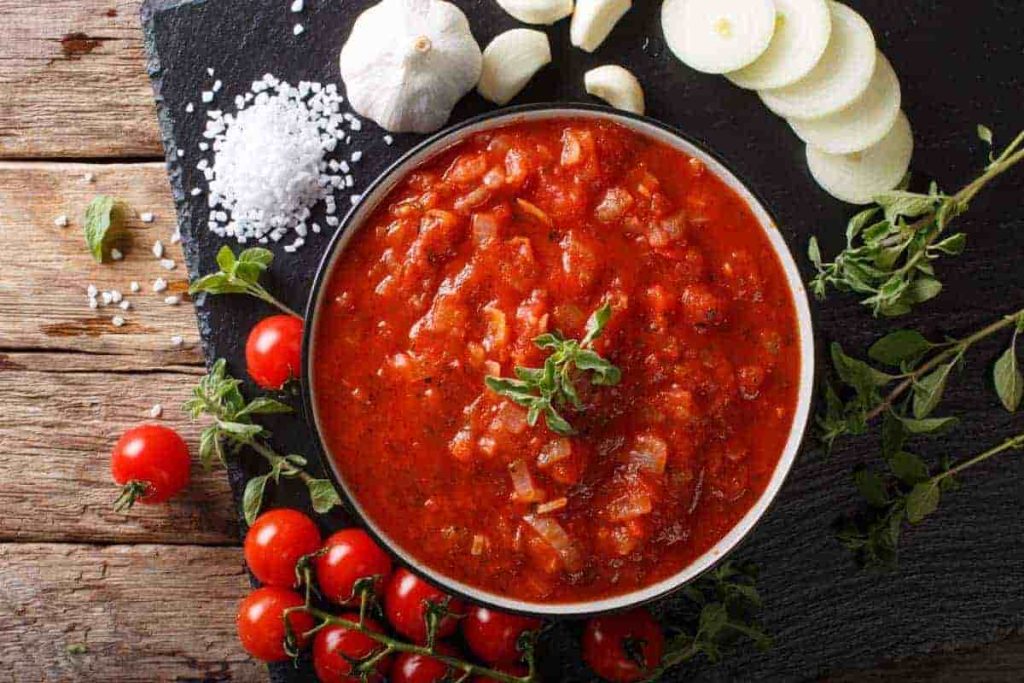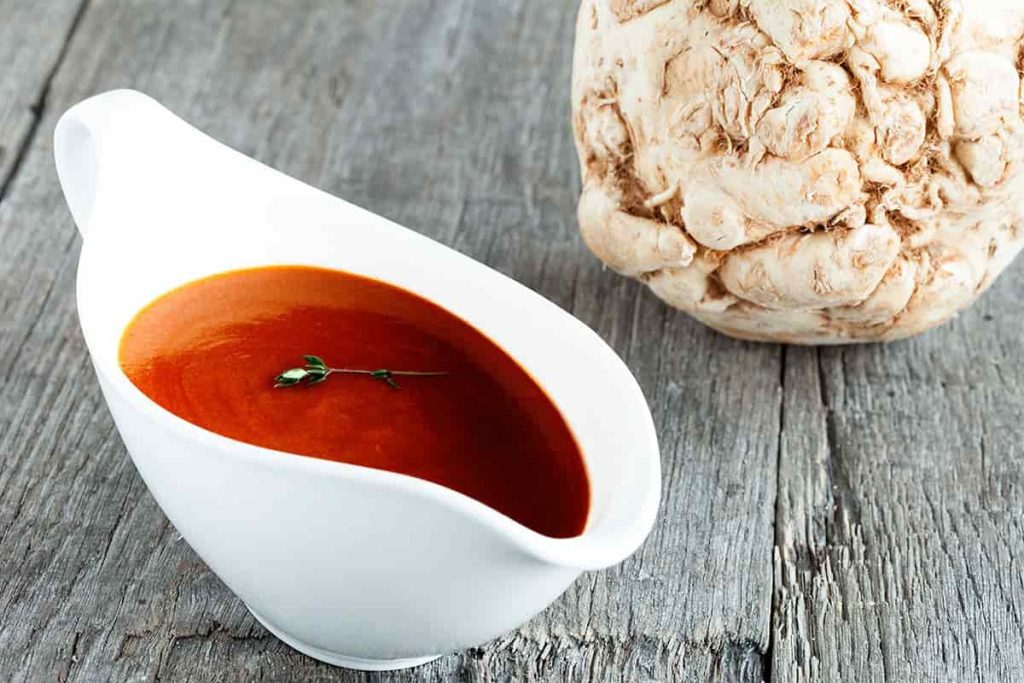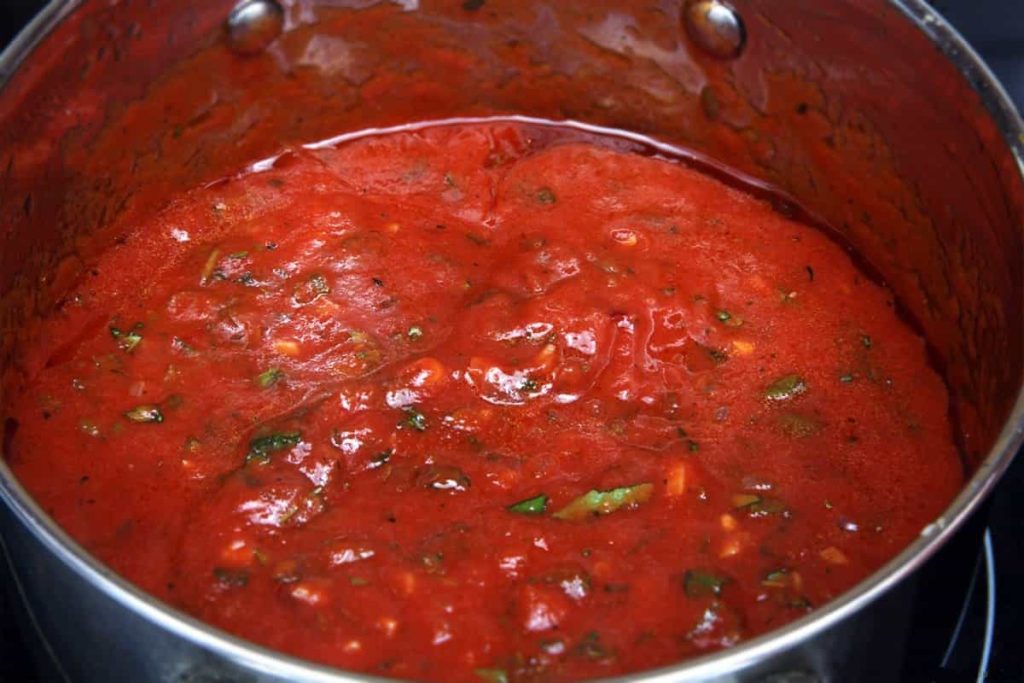With the use of some basic ingredients, you can have your homemade tomato paste. The recipe for it is given in the following parts.
The tomato paste you can purchase at the store is not at all like the kind you can make at home, which yields a product that is not only wholly unique but also significantly more mouthwatering.
It takes approximately a day to make (though, thankfully, much of the labor may be done without your direct participation), but in the end, you will have enough tomato paste to use in a variety of different recipes. In my opinion, it is always more than worth it to make something from scratch.
Tomato paste produced at home versus that purchased from a store:
Tomato paste is a pantry staple for most of us, and it is typically purchased in either small tin cans or (pricy and difficult to find) imported tubes for easy dispensing.
The versions sold in grocery stores are typically nothing exceptional; rather, they are containers of thick, silky tomato concentrate.
When you produce it yourself, you get to decide which tomatoes to use, and as a result, the flavor of the finished concentrate is entirely up to you. Cooking the paste at low heat for a long period results in a flavor that is heartier and more robust than the equivalent product sold in stores.
How to Determine Which Tomatoes to Use for Making Tomato Paste:
One thing you need to keep in mind is that although any type of tomato can be used to make a paste, the yield you get from the paste will vary depending on the type of tomato you choose to use.
When I made it with heirloom slicing tomatoes, the finished product only filled three small jars, but when I used meaty paste tomatoes, I received almost twice as much as that. I recommend using meaty paste tomatoes. Therefore, keep this in mind before you start rummaging through those priceless heirlooms.
How to Keep Your Homemade Tomato Paste Fresh:
If you want to take the easy way out of canning this tomato paste, put the completed paste into ice cube trays, freeze it, and then bag and label the frozen cubes.
The steps for boiling-water canning this tomato paste are included in the recipe that follows below. Pull a cube of tomato paste out of the container whenever you only need a little bit of it. These cubes have a shelf life of up to nine months when frozen.

How to Use Homemade Tomato Paste:
Tomato paste that has been prepared at home yields excellent results in all of the typical applications, including stews, soups, and chili.
The lengthy time spent roasting in the oven, on the other hand, imparts a flavor that is intensely tomatoey and makes it great when scraped over toasted baguette rounds, then topped with fresh ricotta cheese, or when smeared into an omelet that contains spinach.
Tester’s Note:
The following is a list of the questions that are asked the most frequently about this recipe: “Can I use lemon juice instead of citric acid?” in addition to “Will it be worth it?”
To begin, the answer to your question is yes, you can use lemon juice; however, you must use the bottled kind of lemon juice because it has been pasteurized and has a more constant level of acidity than freshly squeezed lemon juice. For this quantity of tomatoes, the Center for Home Preservation suggests using 2 teaspoons of bottled lemon juice instead of fresh lemon juice.
Second, to answer your question, the answer is yes, it is unquestionably worthwhile due to how delicious it is. I’ve never put bottled tomato paste on buttered bread or stirred it into yogurt, but that’s exactly how I’m going to enjoy my handmade batch of tomato paste this summer.
What exactly is the “Tomato Preserving 2.0” method?
When it comes to tomatoes, it’s possible that you already have the fundamentals covered. You have prepared fresh tomato sauce, roasted the tomatoes, or frozen a bag of tomatoes to make peeling and preparing sauce in the future much simpler.

So, what should we do now?
When you are ready to go to the next level of preserving tomatoes, Marisa McClellan of Food in Jars will walk you through Tomato Preserving 2.0. During this class, you will learn new cooking techniques and get some helpful ideas.
INGREDIENTS:
- 10 lbs. of tomatoes
- Olive oil, two tablespoons
- Sea salt, two tablespoons
- 2 tablespoons of bottled lemon juice or 1/2 teaspoon of citric acid
EQUIPMENT:
- Kitchen knife
- chopping block
- massive pot
- chinois, food mill, or sieve
- 2 roasting pans or baking sheets with rims
- 4-ounce jars for holding food
INSTRUCTIONS:
the oven to 350 degrees Fahrenheit. Set up two racks to divide the oven into thirds, then preheat it to 350 degrees.
Tomatoes should be quartered. tomato slices in fourths.
Olive oil and tomatoes are simmered together. Over medium-high heat, place the olive oil in a large pot and stir until shimmering. When the tomatoes are soft and the skins are starting to separate from the flesh, add them back in.
The tomatoes should be run through a food mill.

To separate the tomato pulp from the seeds and skins, push the warm tomatoes through a food mill, sieve, or chinois. The pulp should be mixed with sea salt and lemon juice or citric acid. Seeds and skins should be thrown away or composted.
Put the pulp on two baking trays. The tomato pulp should be divided between 2 sizable, rimmed baking sheets. It will take longer to cook down if you use a large roasting pan instead.
The tomato pulp should be baked until it becomes a paste. In the oven, put the baking sheets. Every half-hour, check on the tomatoes, stir the paste, and rotate the baking sheets to ensure an even reduction.
The paste will gradually start to thin out until it no longer fills the baking sheet. Continue baking after combining the items from the two baking sheets into one.
Bake for a reduction of at least 50%.
The paste is ready when it has been reduced by more than half, is lustrous, brick-colored, and has baked for 3 to 4 hours, however, the precise baking time will depend on how juicy your tomatoes are. At this time, there shouldn’t be any trace of moisture or undissolved water in the paste.
Put jars with the paste inside.
Give each 4-ounce jar 3/4-inch headroom when dividing the finished paste.
Option 1 for preserving: Cook the tomato paste in a hot water bath. Apply the lids and rings, then process for 15 minutes in a pot of boiling water. For up to a year, keep in a cold, dark area.
Refrigerate for up to a week after opening.
Option 2 for preservation: Freeze or refrigerate. The paste can be chilled or frozen if you don’t want to process it. Scrape completed paste into clean half or quarter pint jars.
Place a layer of olive oil on top of each jar before putting it in the freezer or refrigerator. It will keep in the refrigerator for 3 to 4 weeks as long as you keep it well-covered with olive oil and make sure you only take it out of the jar with a very clean spoon. It can be frozen and kept for up to nine months.
NOTES FOR RECIPE:
Options for tomatoes: For the most yield, use paste tomatoes like Romas and San Marzano. Although they will produce a lower yield, juicy heritage tomatoes can also be used.











Your comment submitted.